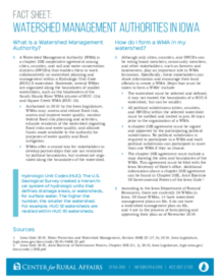What is a Watershed Management Authority?
A Watershed Management Authority (WMA) is a chapter 28E cooperative agreement among cities, counties, and soil and water conservation districts (SWCDs) that enables them to work collaboratively on watershed planning and management within a Hydrologic Unit Code (HUC)-8 watershed. Statewide, several WMAs are organized along the boundaries of smaller watersheds, such as the headwaters of the South Skunk River WMA (cluster of HUC-12s) and Squaw Creek WMA (HUC-10).
- Authorized in 2010 by the Iowa Legislature, WMAs may: assess and reduce flood risk, assess and improve water quality, monitor federal flood risk planning and activities, educate residents of the watershed regarding flood risks and water quality, and allocate funds made available to the authority for purposes of water quality and flood mitigation.
- WMAs offer a crucial way for stakeholders to develop partnerships that are not restricted by political boundaries, but instead are organized along the boundaries of the watershed.
How do I form a WMA in my watershed?
Although only cities, counties, and SWCDs can be voting board members, community members, and other stakeholders, such as farmers and landowners, play an important role in WMA formation. Specifically, these stakeholders can share information and encourage their local officials to create a WMA. Steps that must be taken to form a WMA include:
- The watershed must be selected and defined; it may not exceed the boundaries of a HUC-8 watershed, but can be smaller.
- All political subdivisions (cities, counties, and SWCDs) within the selected watershed must be notified and invited to join 30 days prior to the organization of a WMA.
- A chapter 28E agreement must be signed and approved by the participating political subdivisions. No political subdivision is required to participate in a WMA and each political subdivision can participate in more than one WMA if they so choose.
- The chapter 28E agreement must include a map showing the area and boundaries of the WMA. This agreement must be filed with the Iowa Secretary of State’s office. Additional information about a chapter 28E agreement can be found in Chapter 28E, Joint Exercise Of Governmental Powers of the Iowa Code.
According to the Iowa Department of Natural Resources, there are currently 26 WMAs in Iowa. Of those WMAs, 14 have watershed management plans on file, 8 do not have a watershed management plan on file, and 4 are in the process of formulating and approving their plan as of November 2019.


